
 |
| Home |
BUS-eum 1, a traveling TRACES exhibitScenes from the BUS-eum | video of a typical stop | Post-BUS exhibit scenes Grand
Forks Herald | Lawrence Journal | Slide Show
|
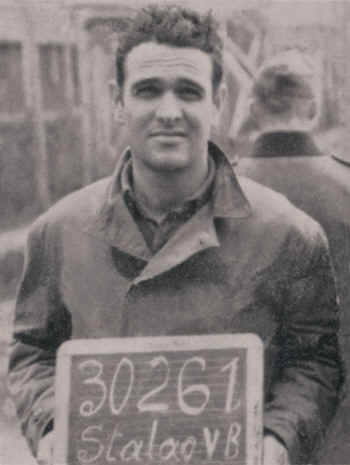 |
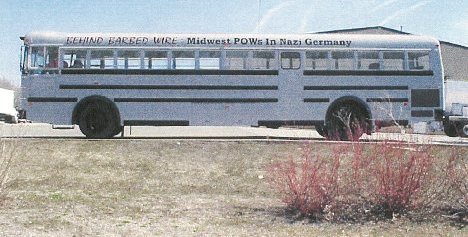 |
|
|
Iowan Thearl Mesecher was a POW in Nazi Germany for 14 months. |
The BUS-eum 1 awaits the installation of graphics and the exhibit, March 2004 |
The Upper Midwest has unique connections to the World War II European-theater prisoner of war (POW) experience. They occurred during the Third Reich, which is what Germany’s Nazis defined as the era of their empire. The first U.S. troops sent to Europe came from the Iowa-based 34th “Red Bull” Division. This division consisted of men from Iowa, the Dakotas and Minnesota. They served for more than 600 days, which was the longest uninterrupted duty of any U.S. unit in the history of the U.S. Army. About 2,000 soldiers from the 34th Division were captured in North Africa in February of 1943. They were captured in February 1943 by German Afrikakorps troops, led by Field Marshall Erwin Rommel. (Thousands of other Midwest men spent time as POWs, too, but in smaller numbers.) Later, pilots shot down during air raids over Germany formed a second wave of Midwest POWs imprisoned in Nazi Germany. Until the Battle of Bulge took place in December of 1944, just west of Germany in Belgium and Luxembourg, a disproportionate share of U.S. POWs in the Third Reich came, per capita, from the Upper Midwest. Minorities were among those POWs and their struggles were worsened by racism within the Army and at home.
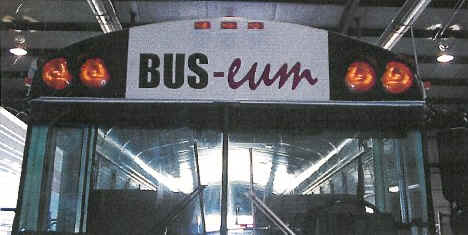 Despite the uniqueness of this legacy, virtually no one is aware of the special role Midwest soldiers played in the larger U.S. WWII experience. This is a disadvantage as we witness yet another cycle of global war and conflict: we forget what our ancestors experienced; we fail to learn from those experiences and apply whatever lessons they might offer us today. The non-profit educational organization TRACES is bringing these stories to life through the creation of its BUS-eum—a 40-foot school bus converted into a mobile museum.
Despite the uniqueness of this legacy, virtually no one is aware of the special role Midwest soldiers played in the larger U.S. WWII experience. This is a disadvantage as we witness yet another cycle of global war and conflict: we forget what our ancestors experienced; we fail to learn from those experiences and apply whatever lessons they might offer us today. The non-profit educational organization TRACES is bringing these stories to life through the creation of its BUS-eum—a 40-foot school bus converted into a mobile museum.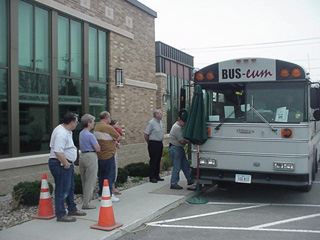
The exhibit consists of narrative display panels illustrated with photographs and documents, audio and DVD documentaries, artifacts and more. This exhibit will bring the stories of Midwest POWs in Nazi Germany to both large and small communities around the region. Remembering the experiences of the POWs in their communities of origin is a unique adventure in U.S. history. The BUS-eum is the only known mobile museum in the nation focused on the experiences and related historical contexts of U.S. POWs. TRACES will bring it to both Dakotas, Nebraska, Kansas, Missouri and Oklahoma between Labor Day and Veterans Day, fall 2007, with the exhibit Behind Barbed Wire: Midwest POWs in Nazi Germany. The BUS-eum will visit the seven other Midwestern states in the next two years.
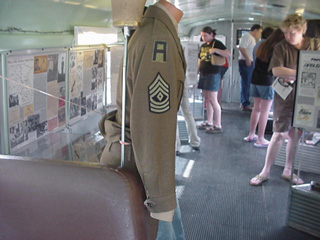 This educational experience has been built upon years of research and gathered support. The International Committee of the Red Cross in Geneva and the Bildarchiv Preussischer Kulturbesitz in Berlin have supplied hundreds of photos for the exhibit that otherwise are unknown in the United States. Indiana-born former POW and best-selling author Kurt Vonnegut has given TRACES free and unrestricted use of Slaughterhouse Five his account of having been present during the firebombing of Dresden. Funding partners in this project include the Iowa Arts Council, Thomas Bus Sales, Firestone Agricultural Tire, WOI Radio, the Gold Star Military Museum, most Midwest states' Humanities councils, civic organizations, private individuals and many more.
This educational experience has been built upon years of research and gathered support. The International Committee of the Red Cross in Geneva and the Bildarchiv Preussischer Kulturbesitz in Berlin have supplied hundreds of photos for the exhibit that otherwise are unknown in the United States. Indiana-born former POW and best-selling author Kurt Vonnegut has given TRACES free and unrestricted use of Slaughterhouse Five his account of having been present during the firebombing of Dresden. Funding partners in this project include the Iowa Arts Council, Thomas Bus Sales, Firestone Agricultural Tire, WOI Radio, the Gold Star Military Museum, most Midwest states' Humanities councils, civic organizations, private individuals and many more.
Beyond Barbed Wire explores the human context of the POW experiences. Implicitly, it addresses five primary questions:
1.) Why did some Midwest POWs survive certain conditions or experiences, while others did not?
2.) What roles did art, free-time, and religion play in helping those men who did survive imprisonment by the Nazi regime?
3.) Why did some Germans or Austrians assist U.S. POWs, while others did not?
4.) How did the liberated POWs later come to terms with their own experiences, and
5.) How do nations and the individuals who constitute a nation come to reconciliation?
The BUS-eum will bring Behind Barbed Wire to hundreds of communities and enrich their historical awareness of their connections to the greater World War II drama. The exhibit will appeal to both children and senior citizens, as well as to urban and rural residents. Valuable discussion and reflection will be sparked amongst diverse audiences about local history and culture, and about current issues related to military service and war. TRACES’ motto is “We bring HISTORY to LIFE!” That mission will be furthered when the BUS-eum tours the very region whose men are celebrated in this unique exhibit.
For more information, to book a showing or to make a donation towards this project, contact:
admin@TRACES.org Please also visit www.TRACES.org.
1729 Hague Avenue #2, Saint Paul/MN 55104
651.646.0400 fax .8070
All organizations and individuals who invest $500 or more (in cash or in-kind) in this special project will be cited prominently on the bus itself.
TRACES is a 501 (c)(3) non-profit educational organization and all contributions are tax-deductible.